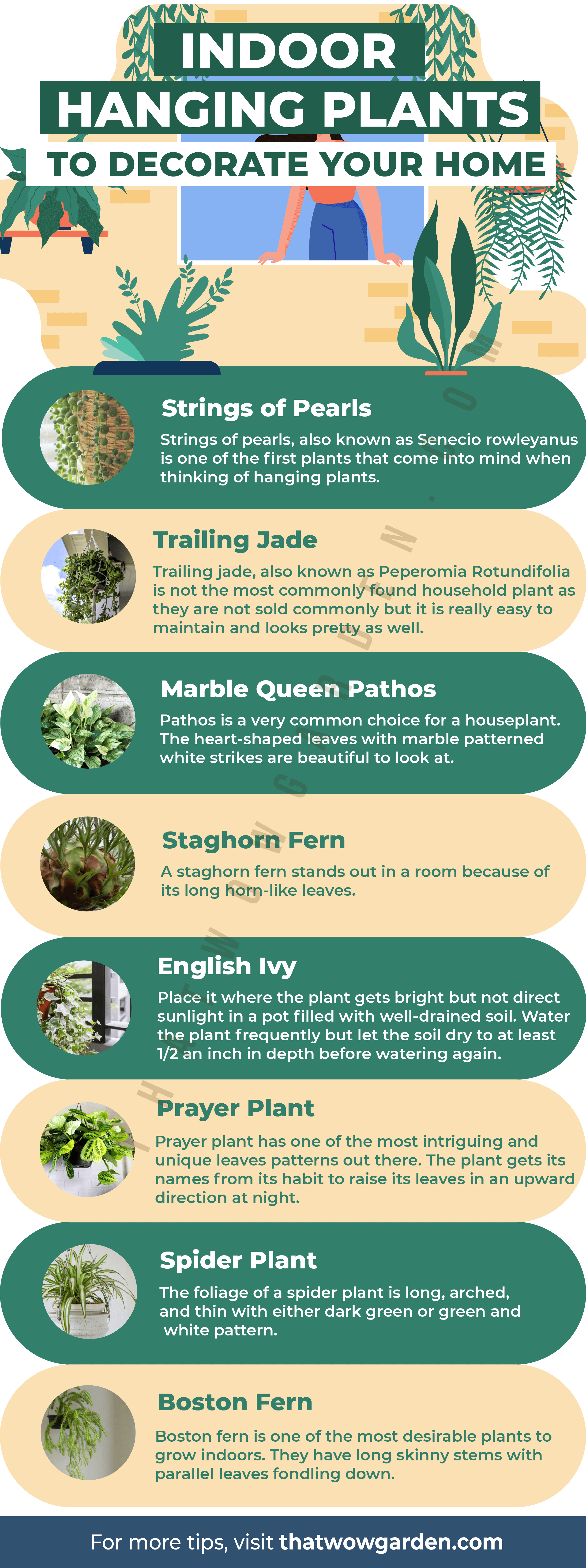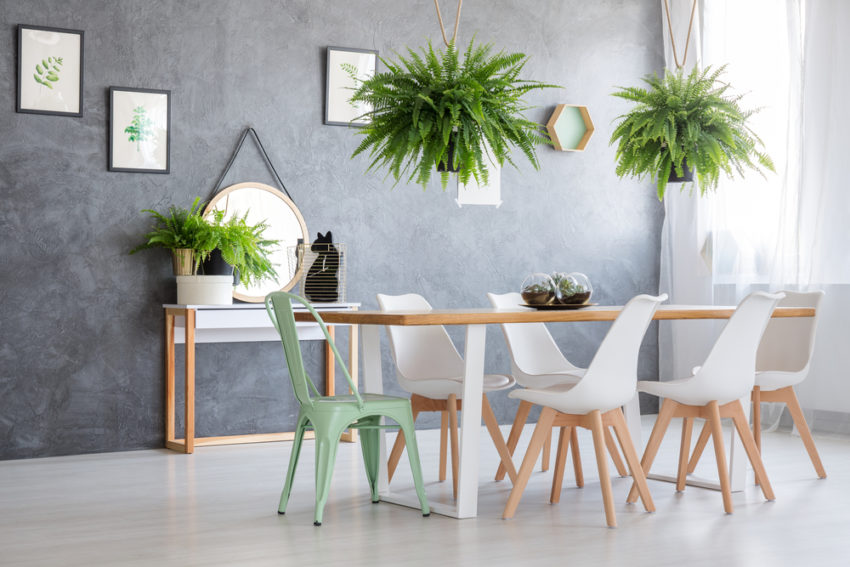Nothing can spruce-up a place more than some additional greens in your life. Houseplants are really good for home decor, they bring a touch of nature inside and if you choose correctly you can grow them even if you don’t have green thumbs. You can start with floor plants like different palms available.
Or you can add cut-blooms from your garden and try infinite possibilities to incorporate them in your home (from stylish vases to bowls to dishes choose creatively). You can also get those small pots for desks and shelves (there are so many plants that can be grown in these pots but recently succulents are trendy, a reason being they are the easiest to take care of). Another possibility is to hang plants, this is one of my favorites sheerly for the fact that they are so chic to look at.
When I was young my mother used to have this beautiful deep green plant of English Ivy hanging on a knotted rope and the rope gave it the bohemian-farmhouse kind of look, the point being, I think that is where my liking for hanging plants came from.
But there are just so many plants to choose from and a lot of chic ways to do it (which I need a whole article to itself). Another good reason why you should have hanging plants is that they are really good when it comes to compact spaces as they make use of vertical space and leaves room on the floor for other furniture and accessories.
Adding plants to your home does so much more than just add to its beauty. Indoor plants purify the air inside your house provides you with more oxygen (especially during night time), improves sleep, helps with insomnia, reduces stress and anxiety, and so on.
Here is curated list of 11 best Indoor Hanging Plants that can bring additional charm to your abode.
1. Strings of Pearls
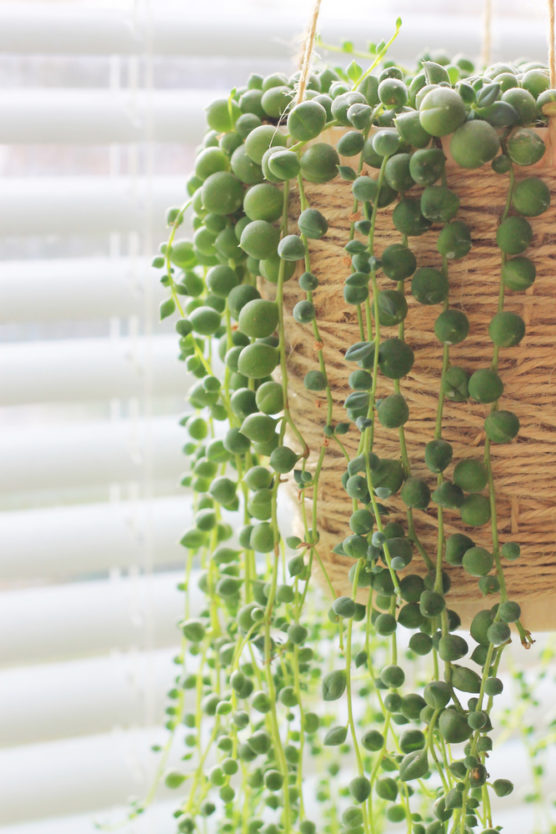
Strings of pearls, also known as Senecio rowleyanus is one of the first plants that come into mind when thinking of hanging plants. It is just as beautiful as the name suggests, pretty strings of beady round greens trailing downwards look amazing when hanged from a height. Interestingly these are also succulents and do not need a lot of maintenance.
Trimming is an integral part of growing trailing plants, so chip of the long trails when they are about to reach the floor. Make sure at least 3 nodes are inside the soil at all times to help the plant propagate as normal. Fill the pot with good well-drained potting soil and top-dress it with compost regularly. Bright filtered light is ideal for the plants. Don’t overwater the plant.
2. Trailing Jade
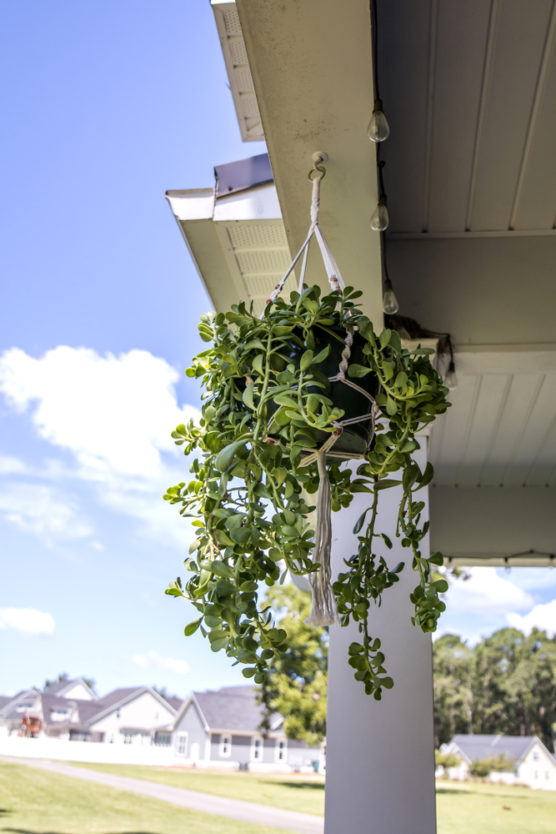
Trailing jade, also known as Peperomia Rotundifolia is not the most commonly found household plant as they are not sold commonly but it is really easy to maintain and looks pretty as well.
It is a beautiful perennial with deep green round leaves. Like all trail plant prune and chip of when the trails get extra long. You can use the cuttings to propagate the plant width wise by planting them back into the soil.
A trailing jade needs a temperature between 65-75 degrees Fahrenheit and should be planted in well-drained soil to flourish. Direct sun and overwatering can to say the least harm the plant. During winters reduce the water to the bare minimum. To have moisture and humidity that the plants are fond of, mist the leaves in summer.
3. Marble Queen Pathos

Pathos is a very common choice for a houseplant. The heart-shaped leaves with marble patterned white strikes are beautiful to look at. Marble queen pathos with its cascading vines is also called devil’s Ivy. They are often supported with a pole but personally, the vines draping down from a height sounds much more interesting.
The pathos family plants are known for their ability to purify the air by removing toxins. Another reason to consider hanging this plant is that it is toxic for pets and children so having it at height will help you keep it away from their reach.
Pathos can survive in low light, but they will thrive under medium to bright indirect sunlight. Use well-aerated and well-drained potting soil. Wait till at least 50% of the soil is dried before watering and don’t make the soil moist as you water. The ideal temperature for marble queen pathos to grow is between 65-85 degrees Fahrenheit.
4. Staghorn Fern
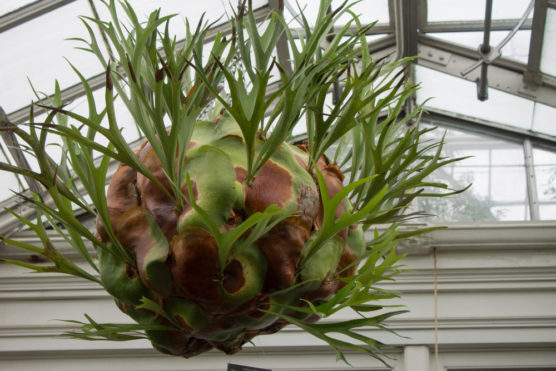
A staghorn fern stands out in a room because of its long horn-like leaves. Rather than hanging them like trailing plants, you can mount them on a wall with the help of a wooden board. Like most plants, ferns do not produce seeds instead they produce pups. Cut off the pup from the parent plant using a knife. Now take some damp sphagnum moss and wrap the end of the cut with it. Now attach it loosely to the wall and nourish it as you would do for an adult staghorn.
Staghorn can survive low light and need moderate humidity. Water them when the soil is almost completely dry. For mounted staghorn ferns use a spray bottle to water it.
5. English Ivy
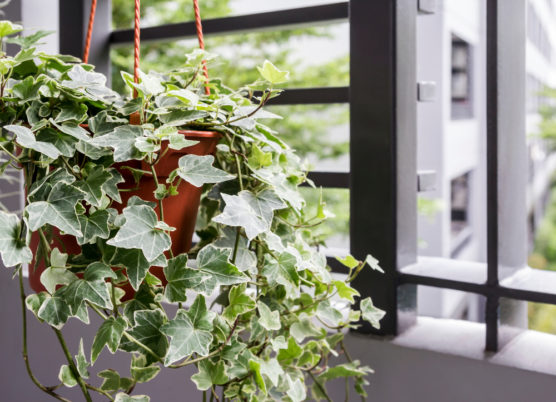
As I said English Ivy is what made me fond of hanging and trailing plants. It is such a beautiful plant with its magnificent deep green leave that fill the cascading vines. You can hang the plant, grow it at the base of other plants, or use a pole to support as it grows upwards.
Place it where the plant gets bright but not direct sunlight in a pot filled with well-drained soil. Water the plant frequently but let the soil dry to at least 1/2 an inch in depth before watering again. The ideal temperature for English ivy to grow is between 60-70 degrees Fahrenheit.
6. Prayer Plant
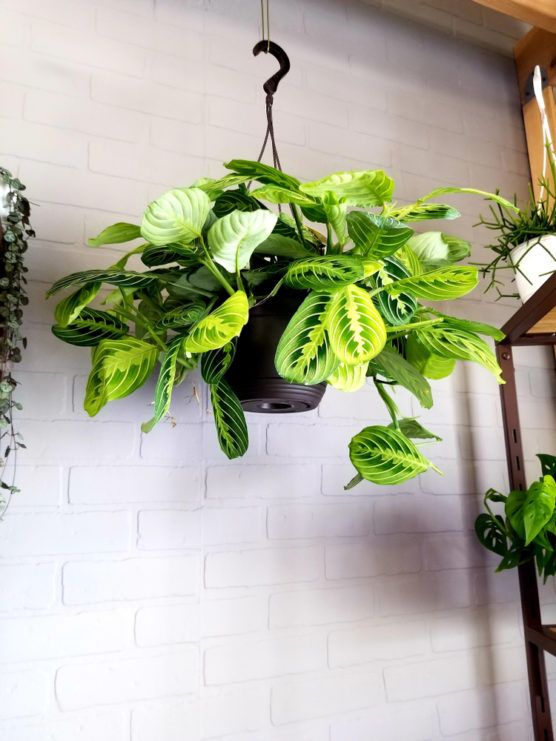
Prayer plant has one of the most intriguing and unique leaves patterns out there. The plant gets its names from its habit to raise its leaves in an upward direction at night. There are many varieties of the plant and many colors its leaves can take.
Direct sunlight can and will hurt the plant. Place it under filtered sunlight in a pot filled with well-drained soil. Drainage can be improved by adding stones and gravel at the bottom of the pot (make sure the pot has good drain holes). Water when the soil’s surface feels drier, make sure the soil is moist but not soggy. Pruning can make the plant grow vigorously by sprouting out new shoots.
7. Spider Plant
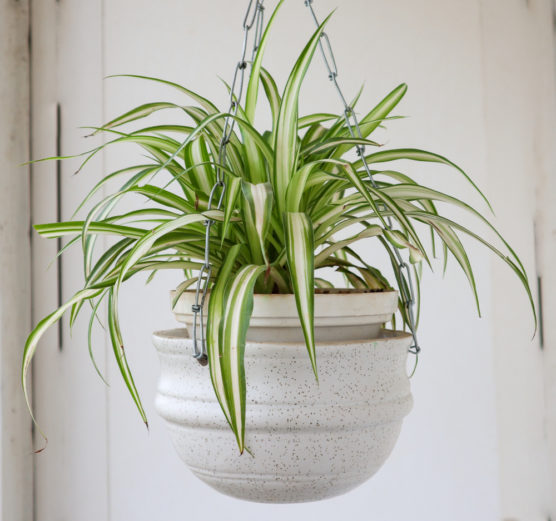
The foliage of a spider plant is long, arched, and thin with either dark green or green and white pattern. Even a beginner at planting can keep this plant healthy with minimal care and simple guidelines.
For spider plants to flourish it needs a well-drained potting mix, moderate indirect sunlight, and occasional watering. You can reduce the watering in winter and make sure that the soil does not completely dry before watering again. Spider plants thrive best in the temperature between 55 – 80 degrees Fahrenheit.
8. Boston Fern
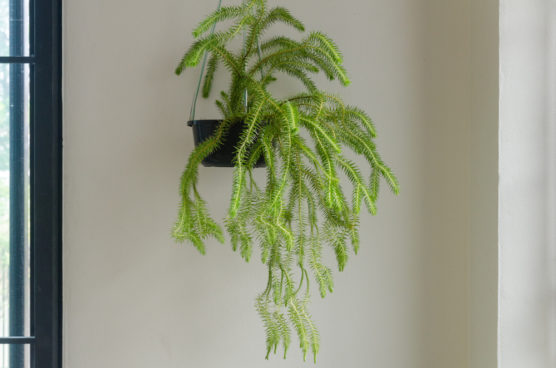
Boston fern is one of the most desirable plants to grow indoors. They have long skinny stems with parallel leaves fondling down. It is tolerant to a higher level of light than most houseplants. Boston ferns can survive the dry conditions which are usually found inside so you have more options when it comes to placement of the fern.
They are tolerant of the brighter sunlight but medium indirect light is more preferable when it comes to Boston ferns. Don’t let the soil completely dry, it should be kept moist almost always. Boston plants thrive in temperature between 60-70 degrees Fahrenheit but it can tolerate colder climate till 50 degrees Fahrenheit. A loamy, rich, well-drained soil with some organic content is the ideal soil for the plant.
9. String of Hearts
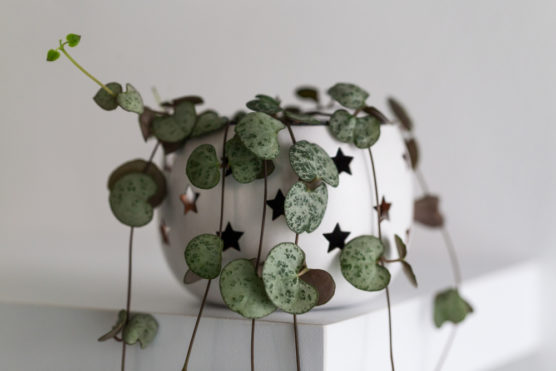
This one is another of my favorite one on the list. The delicate stems draping down from the hanging pot with little hearts that fill the space make it a beautiful houseplant that can instantly decorate any household.
They love bright light but direct light will damage their leaves. To make sure you are growing healthy plants look for the color and space between the leaves. A healthy plant will give tighter packed leaves with brighter colors. It is a succulent so water needs are minimal.
10. Wandering Jew
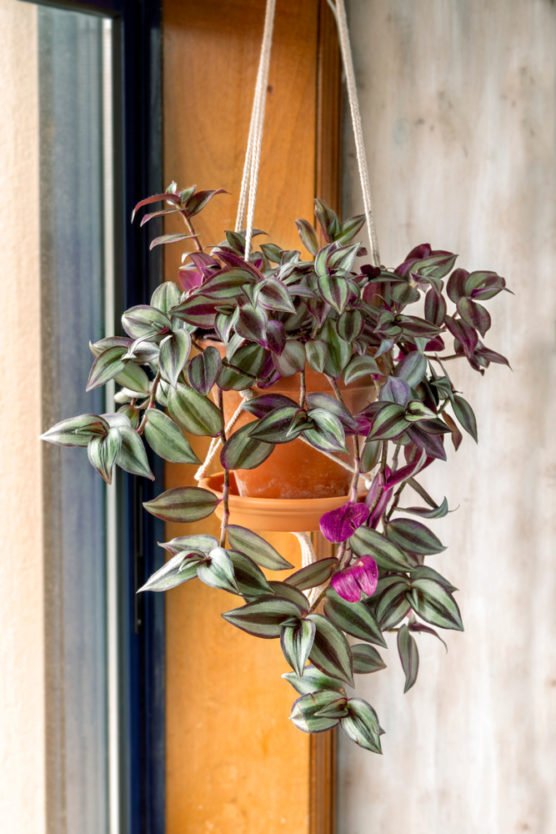
The light and dark vertical pattern on the leaves gives it a more sophisticated and symmetrical look. It is named so because in the old days, gardeners use give cutting from the plants to their loved ones as a good luck charm and like jews, it used to travel from place to place.
Like most houseplants, it also needs well-drained soil and indirect sunlight. But low light can cause the pattern on the leaves to disappear. Water under the leaves and always keep the soil moist but not soggy.
11. Pitcher Plant
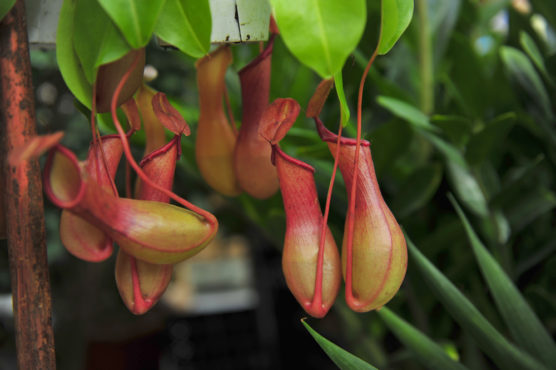
These are a carnivorous plant which makes them unique. They attract insects and consume them, a reason why people often place them in their kitchens to keep the bugs out.
They flourish in medium to bright light, well-drained soil, and moderate watering that will keep the soil moist. Unlike other plants they grow well in low fertility soil, apparently, it is a reason for them being carnivores (since they can’t get nutrients from the soil they get it from the bugs).
